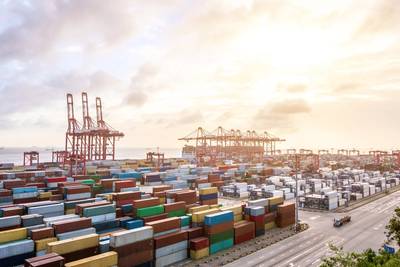China's Export Growth Steady, Import Growth Faster
China maintained solid export growth of 12.6 percent in May, slightly slower than in April, but still providing good news for Beijing's policymakers as they deal with tough trade negotiations with Washington.
Imports also rose more than anticipated in May and at the fastest pace since January, with the data coming at a time when China has pledged to its trade partners - including the United States - that steps would be taken to increase imports.
China, the world's largest exporter, has so far escaped any major blow to its foreign trade sector despite rising trade tensions with the United States, which last week warned it would continue to pursue tariffs on Chinese imports.
That bodes well for the world's second-largest economy, as policymakers tighten access to credit domestically to prevent asset bubbles and limit heavy industry in many regions as part of a big effort to clean up severe air, water and soil pollution.
"Trade performance in Q2 so far has been better than expected and may offer some upside to Q2 GDP growth," Betty Wang, senior China Economist at ANZ, wrote in a note.
But trade tensions with the U.S. remain a risk.
A third round of talks between the two economic heavyweights concluded in Beijing last weekend with few signs of progress, as China issued a counter-warning that any trade and business deals reached with Washington would be void if the United States implemented tariffs.
The median forecast from a Reuters survey of 32 analysts had pointed to 10 percent export growth in May, but the actual outturn showed little loss of momentum, coming in just a shade below the 12.7 percent growth posted in April.
Irrespective of chances of a trade war, analysts warn that China's export growth is likely to stall.
"Even if a trade war is avoided, Chinese trade growth is still likely to edge down over the coming year as the global economy loses momentum and headwinds to domestic demand from slower credit growth intensify," Julian Evans-Pritchard, Senior China Economist at Capital Economics, wrote in a note following the data.
Imports grew 26 percent in May, the General Administration of Customs said, beating analysts' forecast of 18.7 percent growth, and compared with a 21.5 percent rebound in April.
Strong growth in imports were driven by purchases of computer chips as well as commodities including agricultural crude oil, copper ore and concentrate and natural gas.
China is reported to be importing record volumes of U.S. oil and is likely to buy more U.S. soy after Beijing signalled to state-run refiners and grains purchasers they should buy more to help ease trade tensions.
Among major trading partners, China's imports from Australia saw biggest turnaround in growth in May, rising 22.4 percent year-on-year after falling 3.1 percent in April. Imports from South Korea rose 31.8 percent in May.
China's imports and exports both showed stronger growth over the first five months of the year than they did during the same period a year ago, customs data shows.
China' trade surplus narrowed to $24.92 billion in May from $28.38 billion in April, and came in well below analysts forecasts for a $31.9 billion surplus.
Still a widening in China's surplus with the United States is likely to further irritate Washington.
Trade Surplus with U.S. Widens
China's exports to the United States rose 11.6 percent in May from a year earlier, compared with a 9.7 percent rise in April. Its imports from the United States rose 11.4 percent in May, far slower than the 20.3 percent growth shown in April.
That widened China's surplus with the United States to $24.58 billion in May from $22.15 billion in April, according to Reuters calculations based on customs data released on Friday.
For January-May, the surplus stood at $104.85 billion, compared with about $92.9 billion in the same period last year.
China and the United States had appeared to have been on the verge of a truce over trade until the White House warned in late May that it would pursue tariffs on $50 billion worth of Chinese imports, as well as impose restrictions on Chinese investments in the United States and tighter export controls.
A final list of Chinese imports subject to 25 percent tariffs will be announced on June 15, with more detailed investment restrictions to be unveiled by the end of the month.
China agreed to import more energy and agricultural commodities to narrow the $335 billion annual U.S. goods and services trade deficit with China following intensive talks in Washington last month.
Beijing also said it would cut tariffs on nearly 1,500 consumer products as it looks to boost imports as part of efforts to open up the economy.
But analysts say it would be a tall order for China to cut its trade surplus by $200 billion a year as the White House is demanding. To do so, it would have to buy the equivalent of more than 600 Boeing airliners annually.
So far, China's customs hasn't released final April commodities trade statistics which had been due on May 23, and some traders have speculated that Beijing may want to conceal statistics that could somehow undermine its negotiating stance.
(Reporting by Lusha Zhang and Elias Glenn; additional reporting by Stella Qiu; Editing by Simon Cameron-Moore)

















